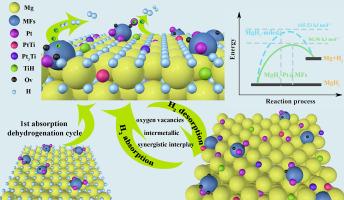氧空位pt负载MAX纤维增强MgH2储氢性能的结构与缺陷工程
IF 13.8
1区 材料科学
Q1 METALLURGY & METALLURGICAL ENGINEERING
引用次数: 0
摘要
氢化镁(MgH2)具有高含氢量和循环稳定性,是一种很有前途的固态储氢材料。然而,它的实际应用受到脱附动力学缓慢和脱氢温度高的限制。为了解决这些问题,利用涡旋和水热法合成了含氧空位的pt负载MAX纤维(Pt@MFs)。研究了Pt@MFs对MgH2储氢性能的影响。结果表明,掺10wt% Pt@MFs的MgH2在169.3℃开始脱氢,在125℃、30 bar氢气压力下,仅30 s就能吸收5.73 wt%的氢气。经过30次循环后,MgH2-10 wt% Pt@MFs保持了其初始容量的98.7%,表现出出色的循环稳定性。在MgH2-10 wt% Pt@MFs复合材料中,MAX纤维网络的活性位点、氧空位、锚定Pt纳米粒子和金属间化合物(PtTi、Pt3Ti)的协同效应通过促进扩散、优化电子转移和减弱Mg-H键显著增强了氢储存动力学。这种材料的设计理念为改善MgH2的动力学和稳定性提供了一种新的策略。本文章由计算机程序翻译,如有差异,请以英文原文为准。

Structural and defect engineering of Pt-loaded MAX fibers with oxygen vacancies for enhanced hydrogen storage properties of MgH2
Magnesium hydride (MgH2) is a promising solid-state hydrogen storage material due to its high hydrogen content and cyclic stability. However, its practical applications are limited by slow desorption kinetics and a high dehydrogenation temperature. To address these challenges, Pt-loaded MAX fibers with oxygen vacancies (Pt@MFs) have been synthesized by using vortex and hydrothermal methods. And the effects of the Pt@MFs on the hydrogen storage properties of MgH2 are investigated. The results display that the MgH2 doped with 10wt% Pt@MFs begins dehydrogenation at 169.3 °C and absorbs 5.73 wt% hydrogen in just 30 s at 125 °C and 30 bar hydrogen pressure. After 30 cycles, the MgH2–10 wt% Pt@MFs retains 98.7% of its initial capacity, showcasing excellent cycling stability. The synergistic effect of the MAX fiber network's active sites, oxygen vacancies, anchored Pt nanoparticles and intermetallic compounds (PtTi, Pt3Ti) in the MgH2–10 wt% Pt@MFs composite significantly enhances hydrogen storage kinetics by facilitating diffusion, optimizing electron transfer, and weakening Mg-H bonds. The design concept of this material offers a novel strategy for improving the kinetics and stability of MgH2.
求助全文
通过发布文献求助,成功后即可免费获取论文全文。
去求助
来源期刊

Journal of Magnesium and Alloys
Engineering-Mechanics of Materials
CiteScore
20.20
自引率
14.80%
发文量
52
审稿时长
59 days
期刊介绍:
The Journal of Magnesium and Alloys serves as a global platform for both theoretical and experimental studies in magnesium science and engineering. It welcomes submissions investigating various scientific and engineering factors impacting the metallurgy, processing, microstructure, properties, and applications of magnesium and alloys. The journal covers all aspects of magnesium and alloy research, including raw materials, alloy casting, extrusion and deformation, corrosion and surface treatment, joining and machining, simulation and modeling, microstructure evolution and mechanical properties, new alloy development, magnesium-based composites, bio-materials and energy materials, applications, and recycling.
 求助内容:
求助内容: 应助结果提醒方式:
应助结果提醒方式:


